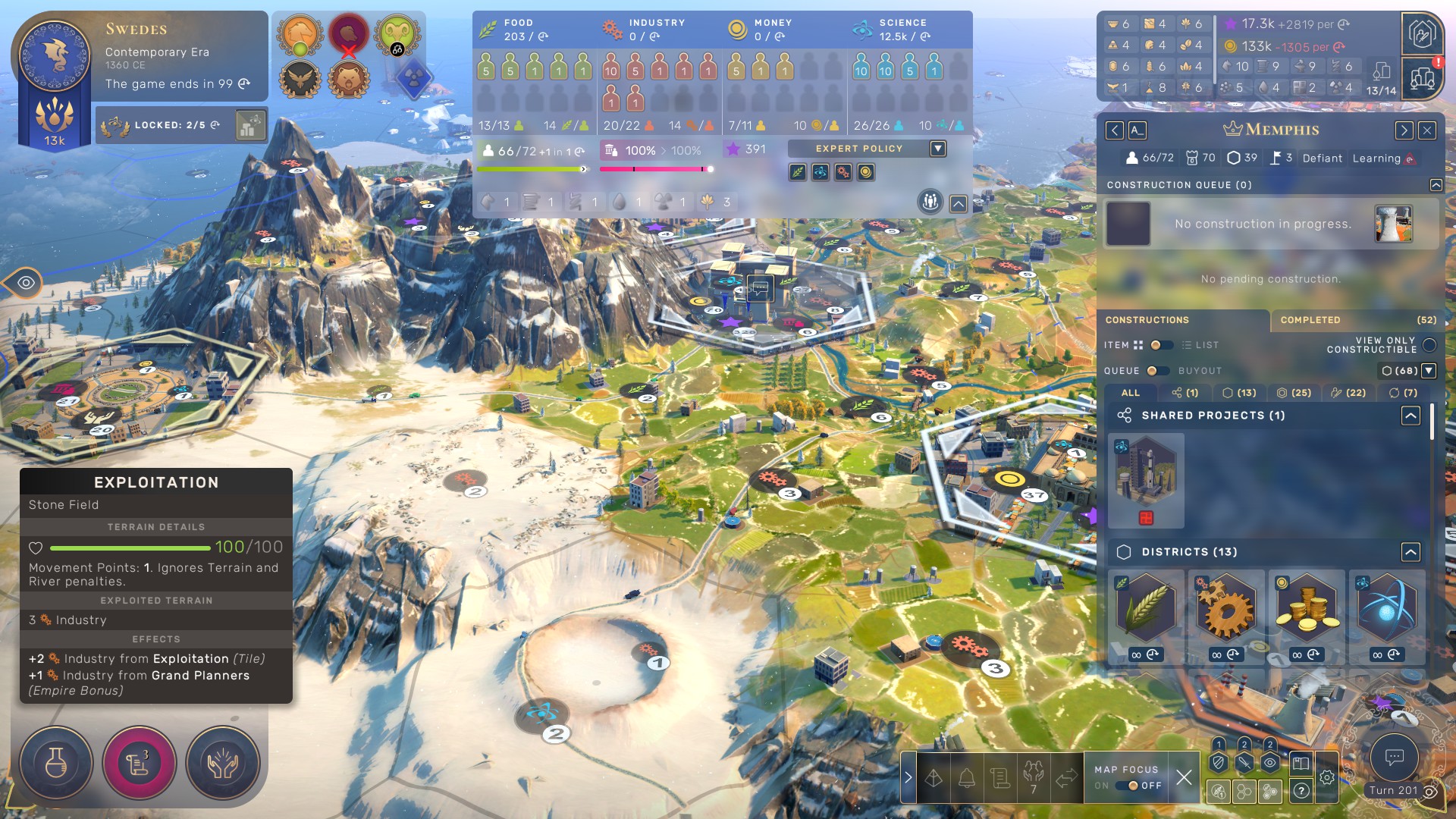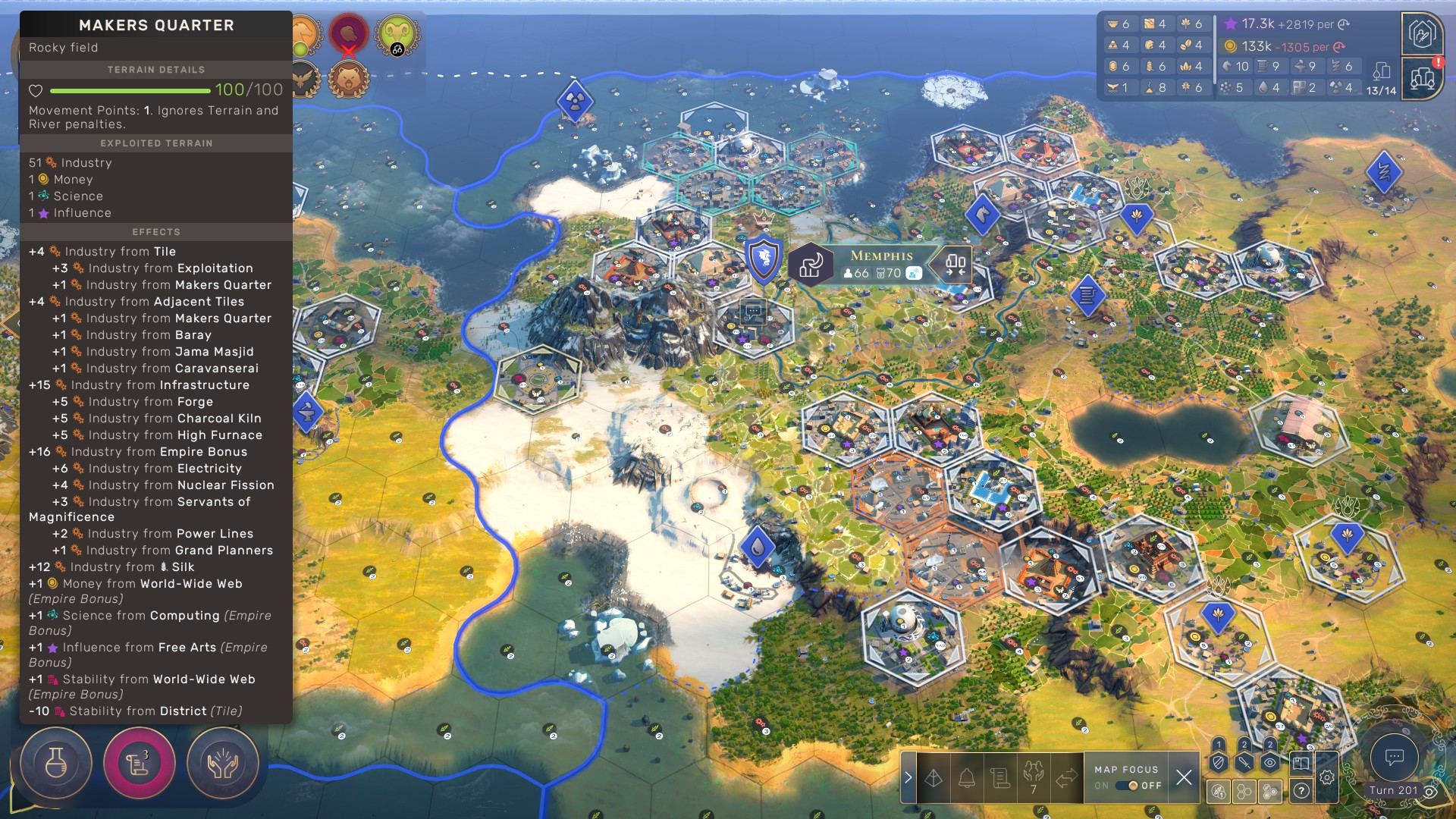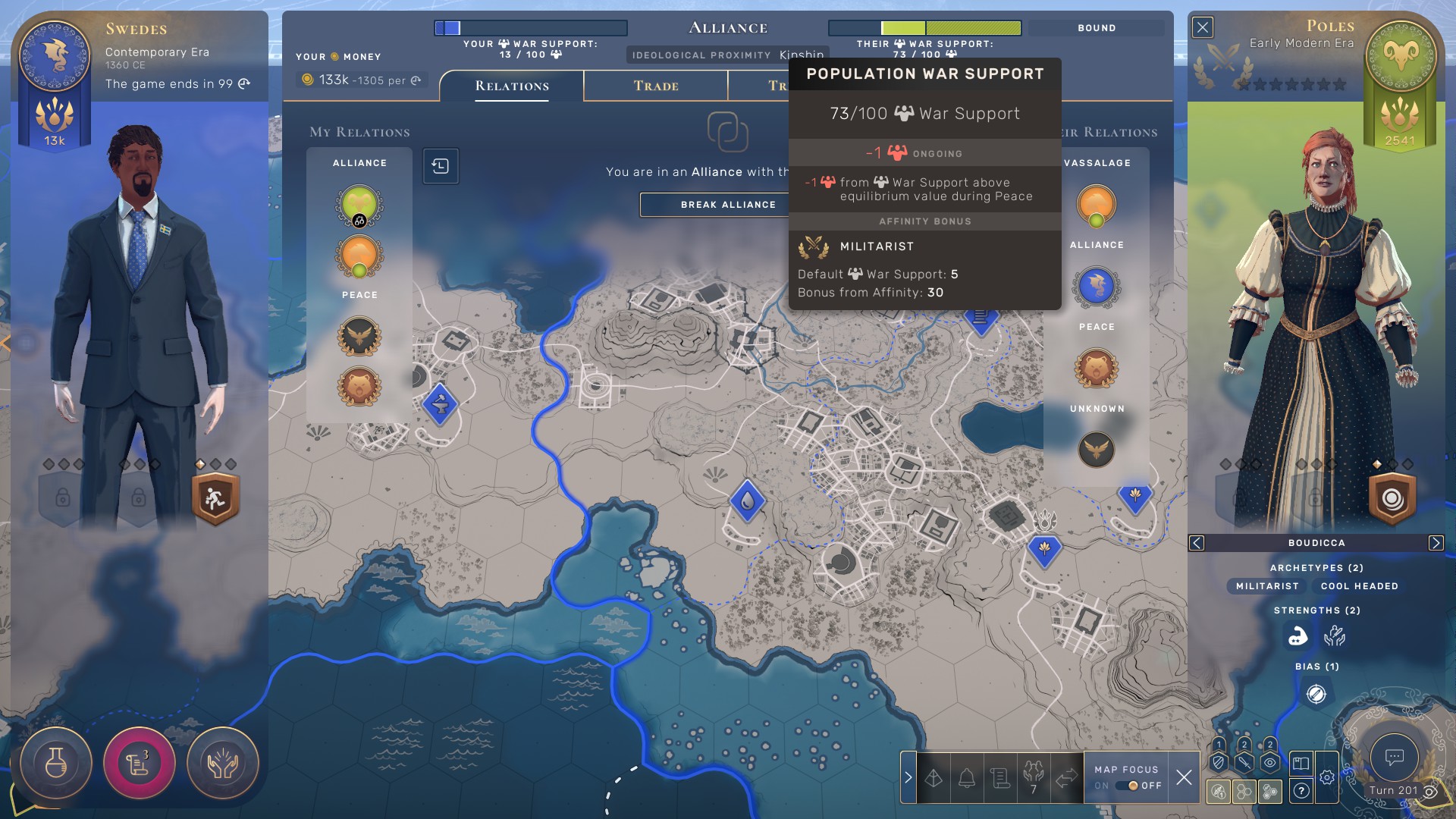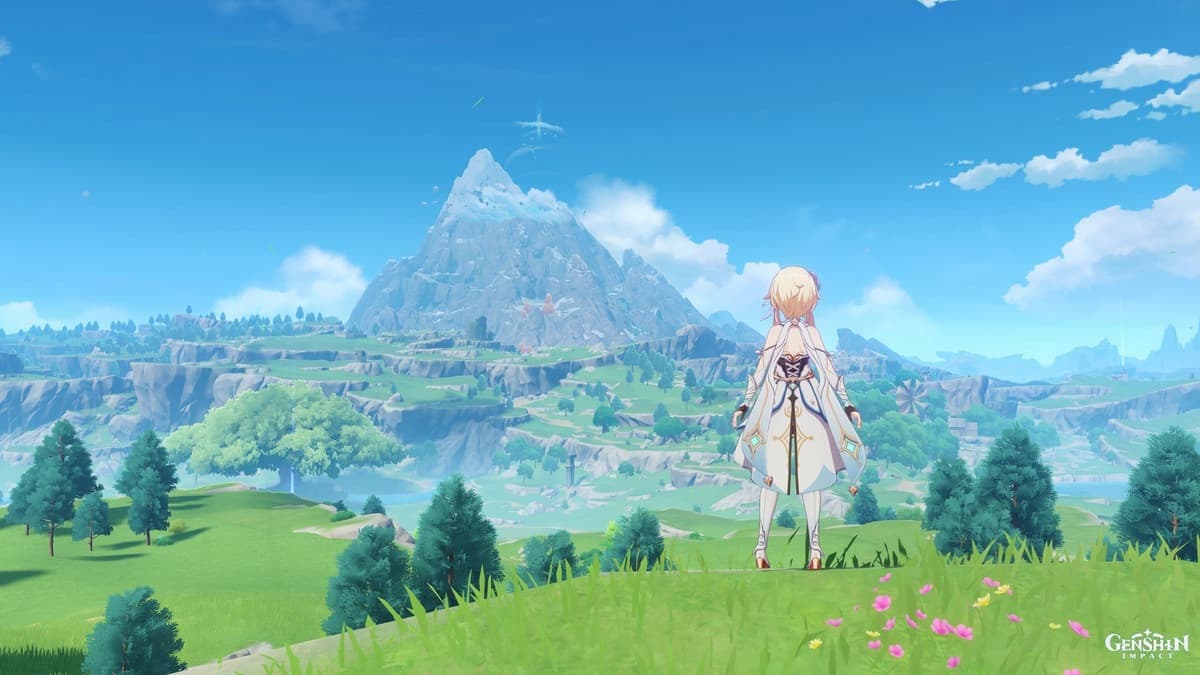In a glass-half-full world, Humankind is a game designed to reward a player who is willing and able to aggressively out-produce their rivals. In a glass-half-empty world, Humankind is downright broken, and producing resources is so grossly overpowered that it becomes the One True Strategy.
So with that in mind, here’s how to get the absolute most out of Humankind‘s resource system so that you’ll be able to punch above your weight. I’ve tested this strategy on difficulties as high as Nation, but if you’re better at 4X games than I am, you could easily take this to a higher level.
Step 1: Get Out of the Neolithic ASAP
The Neolithic era is kind of a random draw, where searching for resources often decides which way you’ll get that all-important first star to advance to the Ancient Age.
You will absolutely want to get the Egyptians before the AI does. It really doesn’t matter whether you get a population of five tribesmen, kill five animals, or accumulate 10 science points from the “goody huts” placed behind the fog of war on the map. Just get the Egyptians first.
The best way to do this is to split your armies; whenever you get a new tribesman, break them off so you can explore more territory in less time.
Step 2: Don’t Get Left Behind on the Tech Tree
If you click on your civ’s logo in the top left corner of the screen, it will show you exactly how much culture, money, science, or whatever else is required to get a star. Seven stars, no matter how you source them, equal an age advance.
The best way to accomplish this is to let your builder advantages drive your production — building Emblematic Quarters and putting Maker’s Quarters around them has a compounding effect — while letting your city workers handle producing food and science.
Ideally, you want a 50/50 split of farmers and scientists; you can do this by selecting the “Expert Priority” approach from the dropdown menu on the city screen, then moving the icons so that, from left to right, they prioritize in order:
- Food
- Science
- Industry
- Money
This is how you get the best of both worlds while also being able to build Infrastructure improvements in your city to augment the output of those city-dwelling workers.
Step 3: Exploit the AI for Fun and Profit
The single biggest determining factor, apart from similar ideology, in whether the AI plays nice with your civilization is military might.
If you can mop the floor with them in a war — hovering over the other civ’s stance toward you, whether “Hesitant,” “Pleasant,” “Aggressive,” etc. will tell you the factors going into that — they’re going to be a lot more receptive to your trade and alliance requests.
Once you’ve got them suitably cowed in fear, you can begin to buy their trade resources. Luxuries will improve your stability and your ability to generate what the game calls “FIMS” (Food/Industry/Money/Science), while strategic resources will augment your own stash for meeting the minimum requirements for various infrastructure and military improvements.
Don’t skimp, and buy everything they have to sell in this order:
- Luxuries
- Science
- Industrial
- Food
This creates a major drag on AI aggression; if there’s a currently active demand from either side, trade stops, and the AI won’t make major demands unless they’re strong enough to back them up. That’s why keeping them in check with a monster army, which you produce because you’re playing a heavy industrial strategy, is important.
Conquer your starting continent. Overseas empires don’t really pose a threat. Potential enemies close to home not only have an easier time in war, but they’re in your way and are best eliminated quickly.
Step 4: Don’t Build Too Many Cities — They Kill
Influence has a huge penalty applied to it if you’re over the city limit. Which means two things.
Having a high city limit is better than having a low one — the sole exception to this rule is when choosing the Maya over the Achaemenid Persians in the Classical Age because production beats city limits and everything else. There’s a civic that gives “+1 City Cap”, and any time you can research a tech that increases the cap, prioritize it.
Second, you want to attach your outposts, and the best way to do so is to distribute the nearby hinterlands as evenly as you can between your parent cities, then spread out where you build your wonders and holy sites so that you don’t run into stability problems from those attached outposts.
As an aside, there’s a civic that lets you use money instead of influence to attach and combine outposts and cities. Take that choice, because…
Step 5: Build Wonders
Using production to build influence-producing structures in cities means influence lets you gain access to wonders faster, so you’ll be able to claim them first.
And since you can’t claim another wonder until you’ve built the one you already called, putting a ton of industrial capacity toward those wonders as quickly as possible facilitates this process.
It also ensures that the cities contributing their industry aren’t so tied up in wonder construction that they can’t produce stuff like food and research and military units.
The more wonders you build, the more fame you get (which you’ll need to win the game) and the more benefits you get from those wonders overall. In particular, the Eiffel Tower provides a boost to industry in every city. Which is as immensely powerful as it sounds.
Step 6: Toward the Lategame
Each of the first five steps will get you as many stars in as few turns as possible, rushing you to the Contemporary Era. But in that final era, you’ll break the rules and finally pick the Swedes.
Their Emblematic Quarter is ridiculously overpowered. It gives +3 Science for every district — regardless of what that district produces — in the province in which it’s built, and it also powers up any Research Quarters with which you surround it.
Plus, having the “Scientist” city specialization allows you to turn all of your city’s Industry and Money into Science.
The game ends when any faction discovers every technology in the game, and the late-game techs come with a massive amount of fame, easily enough to win even if you’re behind in Fame late in the game.
Because you’ve spent the previous five Ages maximizing your Industry, that’s a massive amount of Science you’ll produce at the end, so much so that you’ll be unlocking two or three (or more!) techs every turn.
Sidebar: The Grim Victory Through Industry
There’s another, grimmer way to win the game with the industrial strategy; if any civ chooses to render the planet completely uninhabitable by producing massive quantities of pollution, the game absolutely does not judge you negatively for being a Captain Planet villain.
In that scenario, picking the final Industry culture, the Australians, and building their smoke-belching mines while building all the infrastructure improvements to make your Maker’s Quarters pump out emissions will choke the planet into submission. It will also reward you for building a fame lead earlier in the game.
Step 10: OK, But What If You Get Beaten to the Best Civs?
Sometimes you’ll get an AI opponent who just wants to ruin your day, and they get the Egyptians first out of the Neolithic.
You’ll be tempted to reload Humankind and start over, and I won’t be the one to tell you not to do that.
But if you want to win despite not getting the industrial cultures bonus, the best thing to do is to aggressively build Maker’s Quarters until your stability drops low enough that it’s just over the 30% threshold that triggers a mutiny.
Since you won’t have those massive built-in production bonuses until you’re able to star-rush ahead of whoever beat you to the Egyptians, you’ll want to gain the ability to spend money to complete constructions and really hit hard on anything that builds your economy.
Buying production is far less efficient than producing it, but if the end result is that you get those stars and back into the lead, then do what you have to do in order to make that possible.
If you know you’re going to be beaten to the Egyptians in the Neolithic, then make sure you don’t age up until you get 10 Science, then pick the “Wattle and Daub” perk so that at least you get a +1 to industry for every citizen you have. It’s better than nothing.
—
Every game, no matter how hard it tries to balance competing interests and provide for multiple playstyles, is ultimately going to have the One Stat to Rule Them All. And in the rock-paper-scissors world of Humankind, that stat is industrial production, the “nothing beats rock” Seinfeldian superpower.
Once you know how to manipulate the Humankind resource system, you’ll know how to gain an edge on all mankind.










Published: Aug 23, 2021 11:22 pm